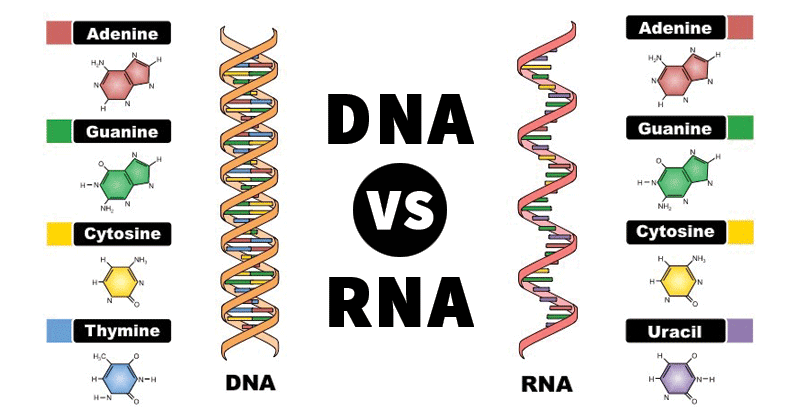Interesting Science Videos
Differences between DNA and RNA (DNA vs RNA)

Some of the differences are:
S.N. |
Character |
DNA |
RNA |
| 1. | Full form | Deoxyribonucleic Acid | Ribonucleic Acid |
| 2. | Location | DNA is found in the nucleus, with a small amount of DNA also present in mitochondria. | RNA forms in the nucleolus, and then moves to specialized regions of the cytoplasm depending on the type of RNA formed. |
| 3. | Structure | Long, ladder-like macromolecule that twists to form a double helix. | In contrast to the double helix structure of DNA, RNA is generally single stranded. |
| 4. | Helix Geometry | The helix geometry of DNA is of β-form. | The helix geometry of RNA is of α-form. |
| 5. | Nucleotides | Each DNA nucleotide contains one of four nitrogenous bases, abbreviated A (adenine), G (guanine), T (thymine), or C (cytosine). | Contains the nitrogenous base uracil in place of thymine. |
| 6. | Chain of Nucleotides | Long chain of nucleotides | Relatively short chains |
| 7. | Sugar | DNA contains deoxyribose sugar. | Contains a different sugar (ribose rather than deoxyribose) in its nucleotides. |
| 8. | Base Pairs | Adenine and Thymine pair (A-T)
Cytosine and Guanine pair (C-G) |
Adenine and Uracil pair (A-U)
Cytosine and Guanine pair (C-G) |
| 9. | Ratio of Bases | In case of DNA: • Adenine = Thymine • Guanine = Cytosine |
In case of RNA: • Adenine ≠ Thymine • Guanine ≠ Cytosine |
| 10. | Molecular Weight | 2 to 6 million | 25,000 to 2 million |
| 11. | Number | For a particular species, the DNA number remains constant for every cell. | The number of RNA may differ from cell to cell. |
| 12. | Molecule | DNA does not usually exist as a single molecule, but instead as a tightly-associated pair of molecules. | RNA may exist as a single molecule. |
| 13. | Propagation | DNA is self-replicating. | RNA is synthesized from DNA on an as-needed basis. |
| 14. | Major enzyme involved in propagation | DNA polymerase | RNA polymerase |
| 15. | Need of Primer | Primer necessary to initiate replication. | No primer is needed for RNA. |
| 16. | Proof-reading activity | Present. | Absent since RNA polymerase lacks the ability to detect errors of base pairing. |
| 17. | Polymer length | DNA is a much longer polymer than RNA. A chromosome, for example, is a single, long DNA molecule, which would be several centimetres in length when unravelled. | RNA molecules are variable in length, but much shorter than long DNA polymers. A large RNA molecule might only be a few thousand base pairs long. |
| 18. | Leaving Nucleus | DNA can’t leave the nucleus. | RNA leaves the nucleus (mRNA). |
| 19. | Complementary forms | Complementary forms are mostly between two DNA strands. | RNA strand can form complementary structures with strands of either DNA or RNA. |
| 20. | Destruction and re-use | DNA is completely protected by the body i.e. the body destroys enzymes that cleave DNA. | RNA strands are continually made, broken down and reused. |
| 21. | Hydrolyzing enzyme | DNase | RNase |
| 22. | Function | • Storing genetic information • Directs protein synthesis • Determines genetic coding • Directly responsible for metabolic activities, evolution, heredity, and differentiation. |
• Transferring genetic information from the DNA to proteins • Carrying it outside the nucleus • Translating it to proteins |
| 23. | Role as Genetic Material | In all organisms other than certain viruses | Very rarely (in some viruses) |
| 24. | Versatility and Usefulness | More stable and holds more complex information for longer periods of time. | RNA is more versatile than DNA, capable of performing numerous, diverse tasks in an organism. |
| 25. | Stability | Due to its deoxyribose sugar, which contains one less oxygen-containing hydroxyl group, DNA is a more stable molecule than RNA. DNA is stable under alkaline conditions. | RNA, containing a ribose sugar, is more reactive than DNA and is not stable in alkaline conditions. RNA’s larger helical grooves mean it is more easily subject to attack by enzymes. |
| 26. | Ultraviolet (UV) Sensitivity | DNA is vulnerable to damage by ultraviolet light. | RNA is more resistant to damage from UV light than DNA. |
| 27. | Mutation Rate | DNA’s mutation rate is relatively lower. | RNA’s mutation rate is relatively higher. |
| 28. | Unusual Bases | Never | May be present rarely |
| 29. | Rate of Renaturation After Melting | Relatively slower | Quick |
| 30. | Types | Chromosomal DNA (nuclear DNA) and Extra-chromosomal (plasmid DNA, mt- DNA, chl- DNA etc.) | Messenger RNA (mRNA) Transfer RNA (tRNA) Ribosomal RNA (rRNA)
hnRNA • snRNA • snoRNA • miRNA • siRNA |
References
- https://www.technologynetworks.com/genomics/lists/what-are-the-key-differences-between-dna-and-rna-296719
- https://www.thoughtco.com/dna-versus-rna-608191
- https://en.wikibooks.org/wiki/Structural_Biochemistry/Nucleic_Acid/Difference_between_DNA_and_RNA
- https://biologywise.com/difference-between-dna-rna
DNA vs RNA Video


Thanks alot
does the RNA change the DNA of humans?
very well
DNA contains deoxyribose sugar.
30th types of DNA is wrong, it’s actually, Chromosomal DNA (nuclear DNA) and Extra-chromosomal(plasmid DNA, mt- DNA, chl- DNA etc.)
Thanks, it has been corrected !!!
Awesome thankyou